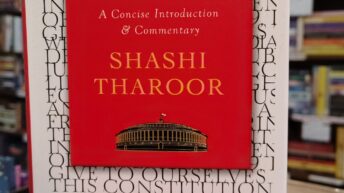
“An Episode from the Realm of Conjecture….Chronicle of Kaalraatri” and its description was such a hook which caught my attention and kept me glued to the very end of the book. This “Chronicle of Kaalraatri” is very much imaginary and portrayed as might happen sometime in future New India as the dramatic and audacious response of the Indian government to the Chinese occupying Galwan heights, completely in sync with the aspirations of an emerging ‘New India’- the ‘Bharat’ as the author calls. The feelings that were generated in the midst of all the action and high drama of espionage, intelligence, diplomacy, and foreign intervention ran a high dose of adrenalin in my veins. At the same time, it made me feel that I was a privileged witness to the game of high diplomacy and top warfare strategy.
The book is about the Chinese and Indian army face-off at Galwan Heights during May-June’20 resulting in a number of casualties on both the Indian and Chinese sides including Indian Army Commander Col. Santosh Babu and purportedly one of the Chinese commanders too. The book retrieves the history of hostilities between India and China since the late forties & early fifties and later the annexation of Tibet. The hostilities have been over the Indian territories of Arunachal Pradesh (NWFA then), Sikkim (a protectorate of India then) and the Ladakh region and still remain unsolved to date, even after protracted rounds of meetings, negotiations and high-level dialogues during the last 70 years. Col Sidhu identifies them as resulting from Beijing’s expansionist policies, currently being displayed in Ladakh and on the northern borders and finally outlines his options and strategies in dealing with China in the longer term.
The author’s prognosis of the problem India has vis-a-vis China is very well articulated when he identifies New Delhi’s lack of deep strategic thinking and its focus on internal issues, whereas China took the opportunity for its all-round development to regain its lost power after the “Century of humiliation” and it has now emerged as a superpower in the making while harbouring its ambitions of displacing the sole superpower of the world today, the US. He looks at the India-China clash as a civilisational clash, with India viewing the world as “Vasudev Kutumbakam”, while China views itself as the “Centre of Civilisation”. Its Middle Kingdom perception of the Chinese Emperor as the ‘Son of Heaven’ to whom all must kowtow and of the surrounding tributary states remains the State’s template even today. The Belt & Road Initiative comes as one such endeavour for projecting its power all the way to the Middle East, Asia, Europe and even South America. It now increasingly sees India, ‘resurgent Bharat’ as a threat to the fulfillment of its plan for worldwide dominance. The author has articulated his position and in a very lucid way.
The book shows that the author has done in-depth research when he outlines how China is involved in creating an alternative global infrastructure through the use of the State. It has set up global corporations which indulge in price fixing, currency manipulations, and coercive use of state control while investing through proxy companies to acquire controlling stakes in global corporations and businesses toward meeting this objective.
The book is written in simple English without military jargon. The flow of the chapters and paragraphs remains unbroken and fluid throughout the book and the thoughts flow seamlessly.
The book was written after the Galwan incursions and is hence quite timely. The dispute over the line of control is still hanging fire through the third winter and there have been almost 16 rounds of talks with the Chinese Military leadership. It is a sort of vision document for 2030 suggesting how India may counter the Chinese threat in the long run. The target audience includes students of Chinese Studies, International relations scholars, diplomats, Military personnel and bureaucrats.
The section “Strategic Dilemmas of China: Maritime Vulnerability” on p.214 provides a new dimension of knowledge. The book outlines how to disrupt the energy security of China in times of war and points to the Wakhan corridor as an unexplored access route.
All in all, in 220 odd pages, the author has packed a treasure of knowledge about the past and the present while imagining the resurgent India of the future.






Meticulously elaborated.